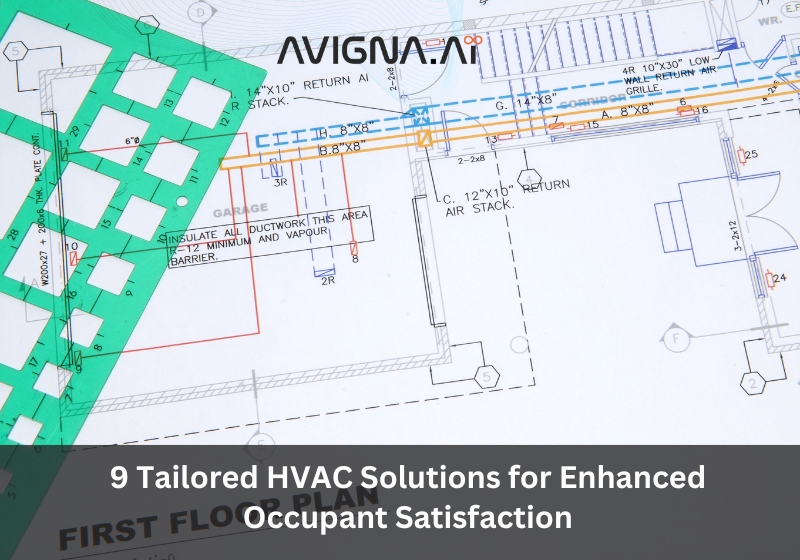9 Tailored HVAC Solutions for Enhanced Occupant Satisfaction
How would you like it to work in an office where the temperature and humidity are unstable? It would indeed be unpleasant. Industry studies state that 43% of the energy used in buildings goes to HVAC, while only 38% of occupants who live in offices are satisfied with temperature regulation. Thus, the first thing a building manager must do is to ensure occupant comfort. With the necessity for varying occupant experience as per different building types and individual tastes, customized HVAC solutions exist.
HVAC Solutions for Enhanced Occupant Satisfaction
The mentioned gap between ambitious sustainability goals and delivering personalized comfort experiences forms the basis of such solutions, out of which ten innovative HVAC strategies tailored for higher occupant satisfaction are as below:
1. Optimized Energy Management
Optimized energy management is one of the most impactful ways HVAC systems can improve user experience. This information helps in making intelligent HVAC adjustments such that:
- During silent hours, smart zoning and constant space utilization monitoring minimize the amount of energy consumed in unoccupied spaces.
- To avoid excessive energy wastage, they monitor trends in occupant comfort and weather patterns and then automatically schedule heating/cooling cycles.
- Thus, backup systems are only engaged as needed, using primarily renewables to limit carbon footprint production.
As a result, buildings can save a lot of energy based on data obtained without compromising on the level of comfort. Consequently, this promotes sustainability while at the same time reducing costs incurred during operation.
2. Advanced Filtration for a Breath of Fresh Air
The health, comfort, and efficiency of those who inhabit a building are greatly influenced by its superior air quality. State-of-the-art particulate filters in HVAC systems ensure fresh indoor air by capturing:
- Ultra-fine dust, pollen, mold spores, and other allergens are down to a micron size.
- Viruses, bacteria, and other bioaerosols that spread illness.
- Harmful chemicals from furnishings, cleaning products, and other indoor sources.
Air filters are assessed through their effectiveness; thus, HEPA and MERV 13 or higher are the preferred choices. Appropriate upkeep, such as timely filter substitution, is also fundamental.
3. Customizable Comfort with Intelligent Controls
There cannot be a universal way to cater to different individual preferences. Intelligent HVAC controls powered by IoT deliver personalized comfort through:
- Smart thermostats allow zone-wise temperature adjustment from any device.
- Occupancy sensors automatically activate/deactivate HVAC in vacant/occupied areas.
- Automated systems are learning user patterns to pre-heat/pre-cool private spaces.
Occupants can adjust their micro-environments toto reach an ideal level of ideal productivity and satisfaction, given the absence of discomfort.
4. Predictive Maintenance for Continuous Operation
One way to ensure that HVAC systems remain reliable is predictive maintenance. There are several users experience advantages associated with this approach. In this regard, IoT-enabled systems make it easier for them to:
- Include real-time remote monitoring to detect faults early enough.
- Data-driven predictive analytics to foresee repair/replacement windows.
- Automated alerts when filters, sensors, or fan motors need servicing.
It replaces costly reactive fixes with planned support. This results in sustained comfort, minimal disruptions, and long-term system optimization.
5. Proactive Humidity Control for a Healthier Ambience
Strict humidity regulation is indispensable for occupant wellness. IoT-driven HVAC solutions maintain the ideal:
- Indoor humidity between 40-60% to discourage microbial growth.
- Low moisture under 30% to control dust mites and airborne allergens.
- High humidity above 60% only when necessary.
Humidity sensors provide real-time data while programmed dehumidifiers/humidifiers adjust settings proactively. This forestalls conditions conducive to illness and creates an environmentally balanced indoor ecosystem.
6. Remote Accessibility for Agile Administration
Cloud-based remote access platforms empower building managers with on-the-go comfort supervision. They facilitate:
- Real-time performance monitoring from any web-enabled device.
- Customized user authorization for tier-wise system controls.
- Remote adjustments are fast-tracking comfort resolutions.
Remote tools substantially improve responsive management standards for enhanced occupancy experiences by removing location restrictions.
7. Integration with Renewables for a Greener Future
The integration leads to net-zero environments using renewable energy sources such as solar, wind, and geo-exchange using HVAC. The advantages include:
- Lowering carbon footprints/suitable for on-site power generation/eventually, we become less dependent on the utility companies.
- Automation that ensures maximum renewable off-take through load management is also sophisticated.
- Energy storage optimizing demand-supply matching for round-the-clock operation.
Such innovations establish sustainability credentials while lowering operational expenses through self-sufficiency over the long term.
8. AI Assimilation for Foremost Efficiency
Artificial intelligence integration undoubtedly takes prevention-oriented HVAC administration up another notch. Some of the abilities that AI has are as follows:
- Extensive lessons learned from huge old BMSs (Building Management Systems) data.
- Advanced predictive analytics projecting service/replacement periods.
- Automated error identification and repair avoidance via real-time monitoring systems for machines.
Employing its constant self-improvement in decision-making processes, AI provides unmatched comfort, cost reduction, environmental conservation, and assurance.
9. Personal Comfort Systems (PCS) for Absolute Control
Some occupants desire absolute climate command over even small personal spaces. PCS or personalized comfort systems reconcile individual needs through:
- Compact desk/workstation-specific fan coil or VTAC units.
- Dedicated smart controls networked to the central BMS for scalable incorporation.
- Plug-and-play installation avoids costly ductwork extension complexity.
By prioritizing the end user, PCS elevates comfort standards to new heights. It cultivates greater productivity, satisfaction, and loyalty.
Closing Thoughts
Through data, personalizing, and sustainable innovation, HVAC strategies are being improved to enhance occupants’ satisfaction within their environments. By integrating emerging solutions, we develop an approach that optimizes indoor comfort holistically while simultaneously being able to withstand future changes in the world.
Offer Ultimate Comfort to Your Occupants with Avigna
Ready to enhance occupant comfort and operational efficiency with tailored HVAC solutions? Contact us today to discover how our award-winning IoT platform Avigna Cube can transform your building’s climate control. To stay in touch with us, join our LinkedIn family.




